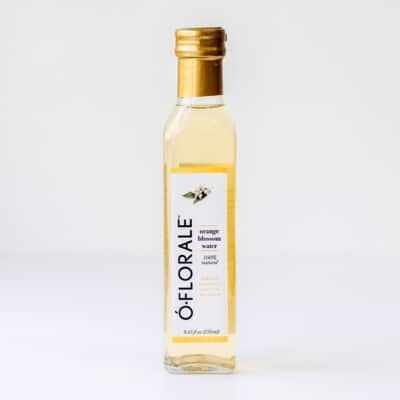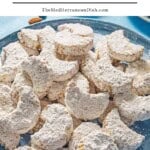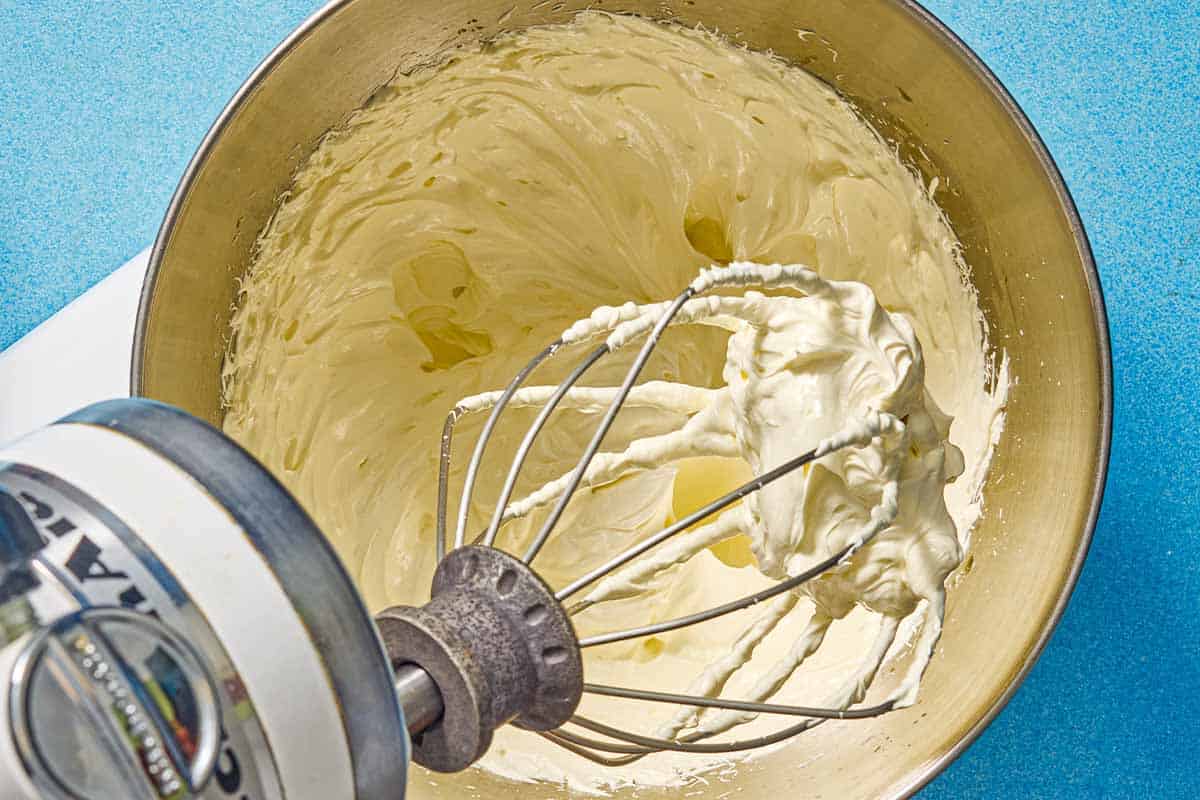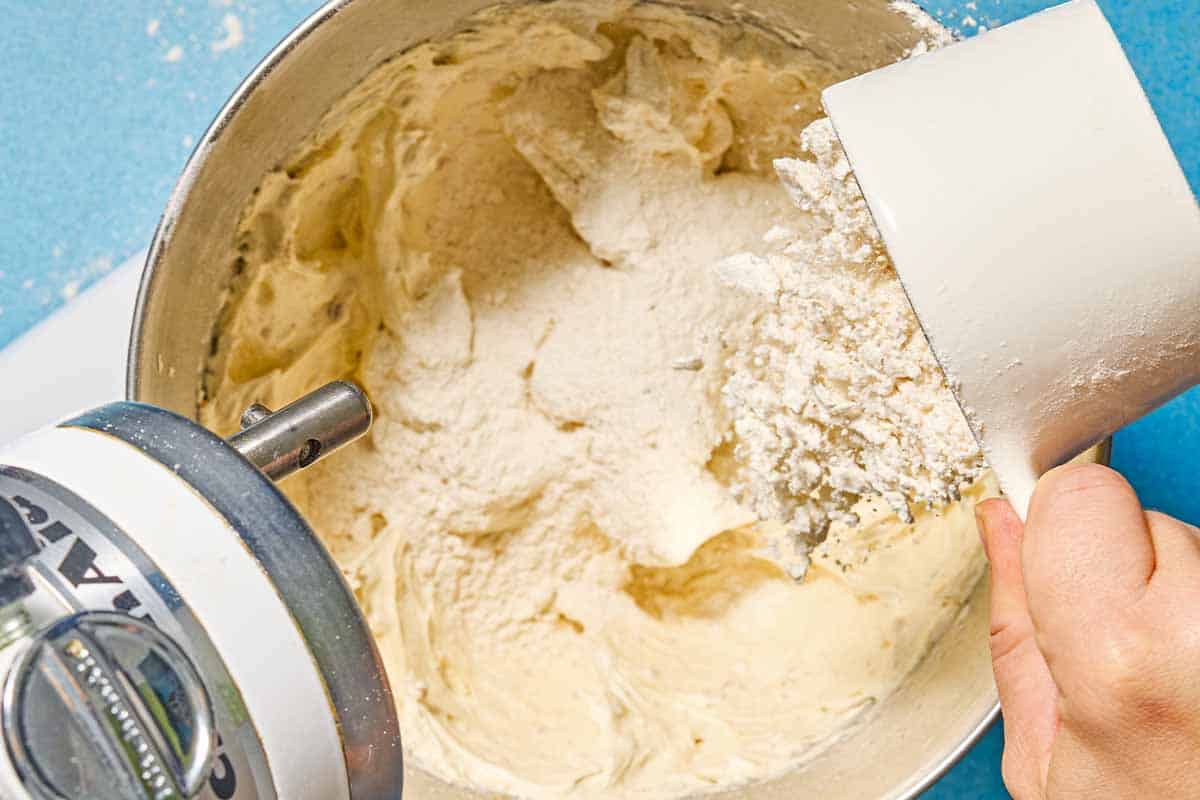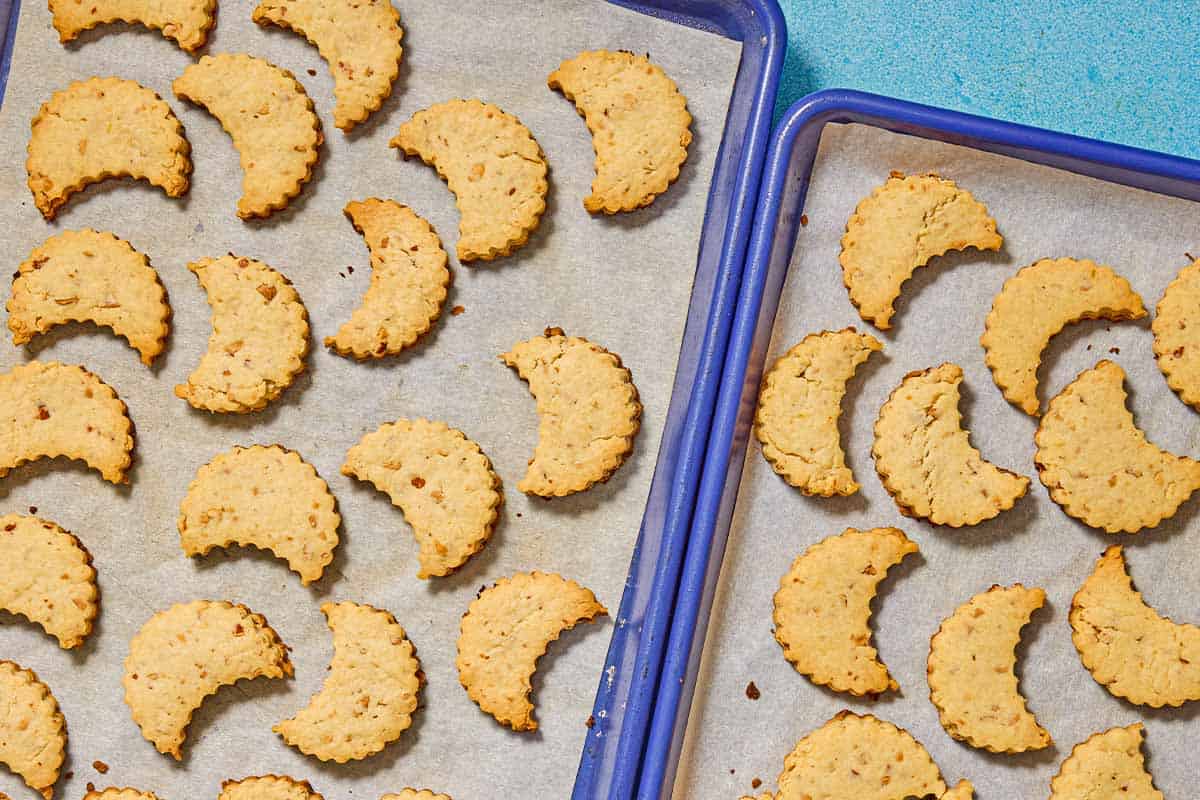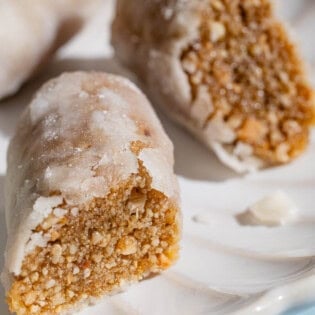Kourabiedes are the quintessential Greek cookie. These tender, crescent-shaped almond cookies, scented with orange zest and orange blossom water, have a wonderful melt-in-the-mouth texture.
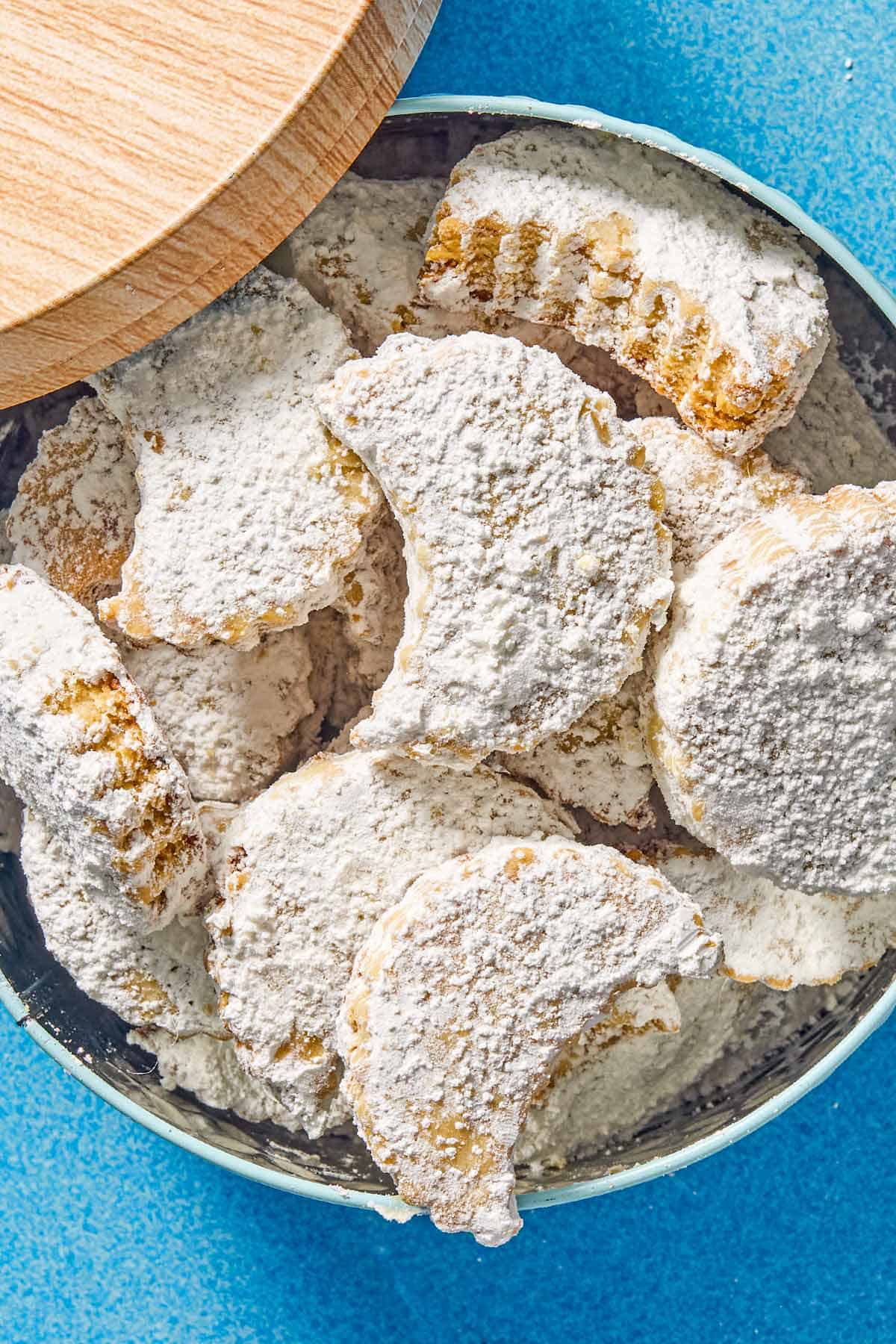
Kourabiedes, sometimes spelled Kourabiethes, and pronounced kou-ra-bie-des are traditional Greek shortbread-style butter cookies, often shaped into crescents or rounds, and heavily dusted with powdered sugar to resemble snowballs.
My recipe has undergone several transformations. I still have a small piece of paper from my mother-in-law, who wrote down her recipe more than 30 years ago. It lists only ingredients without specified amounts, the typical eyeball-and-figure-it-out approach common in Greek families.
I have tried many recipes from aunts and friends, but found most to be somewhat sticky and dense. Unsatisfied, I merged my mother’s version—which uses no butter, only olive oil—with my mother-in-law’s entirely butter-based version. I can confidently say I’ve found the perfect combination for a delightful, crumbly, soft, and flavorful cookie!
Accompanied by Greek coffee and a glass of water, these delightful treats are simple to prepare and taste even better than they look!
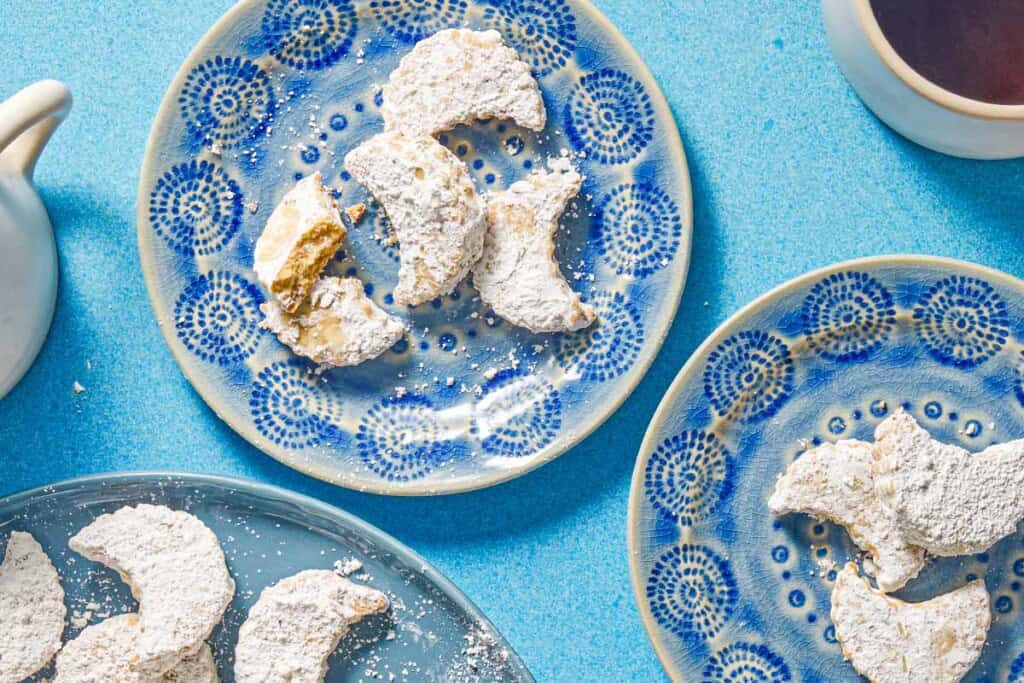
What’s in Greek Cookies (Kourabiedes)?
My recipe for Kourabiedes is based on a kilo of flour, but I’ve adjusted this version to make a more manageable batch and added volume measurements in cups and spoons to make it more accessible for those unaccustomed to baking by weight. Most of the ingredients are standard baking staples. Here’s everything you’ll need:
- Almonds in the dough give the cookies a lovely crunch. I prefer to start with raw almonds with their skins on, though blanched almonds (with their skins removed) work just as well. While nuts are a must in the Greek recipe, you can make these into nut-free cookies by simply omitting them.
- Butter and extra virgin olive oil give these cookies their characteristic richness and crumbly texture. I use unsalted butter, as salted butter has a savory note that, to me, doesn’t fit well in this recipe. But either one will work. Try to source the best quality butter—the flavor makes a big difference. Before you begin, the butter must be at room temperature, as it will be beaten with the olive oil for 10 minutes. Yes, you heard right. You need a lot of air incorporated into the butter and oil. This ensures you achieve the right consistency!
- Egg: A single egg gives richness and structure to the cookie dough. I use whole organic eggs.
- Vanilla gives the cookie a lovely background flavor. You can also substitute almond extract, if you like.
- Baking powder is a leavening agent to help the cookie rise.
- Orange zest gives these cookies a beautiful aroma and flavor. Ensure you have washed your orange well before zesting it with a rasp-style grater.
- Ouzo is a Greek liquor with an anise flavor. The alcohol evaporates as the dough bakes, which gives the cookies a lovely short texture. Feel free to substitute it with brandy or orange liquor, or use water instead.
- Orange blossom water gives the cookie a beautiful, floral, and fresh aroma and flavor. Traditionally, it’s rose water; however, I find that orange blossom water lifts the orange zest in the dough, highlighting the orange flavor.
- Powdered sugar: A small amount sweetens the dough, and the remainder coats the finished cookies. The sugar coating gives these cookies a beautiful snow-dusted effect and festive appearance. I recommend sifting the sugar, if necessary, to remove any lumps.
- All-purpose flour: is the base for the cookie dough. You can also use a gluten-free all-purpose flour blend, but I wouldn’t recommend substituting rye, whole wheat, almond, or coconut flour here. These cookies are meant to be crumbly and tender with a melt-in-your-mouth texture.
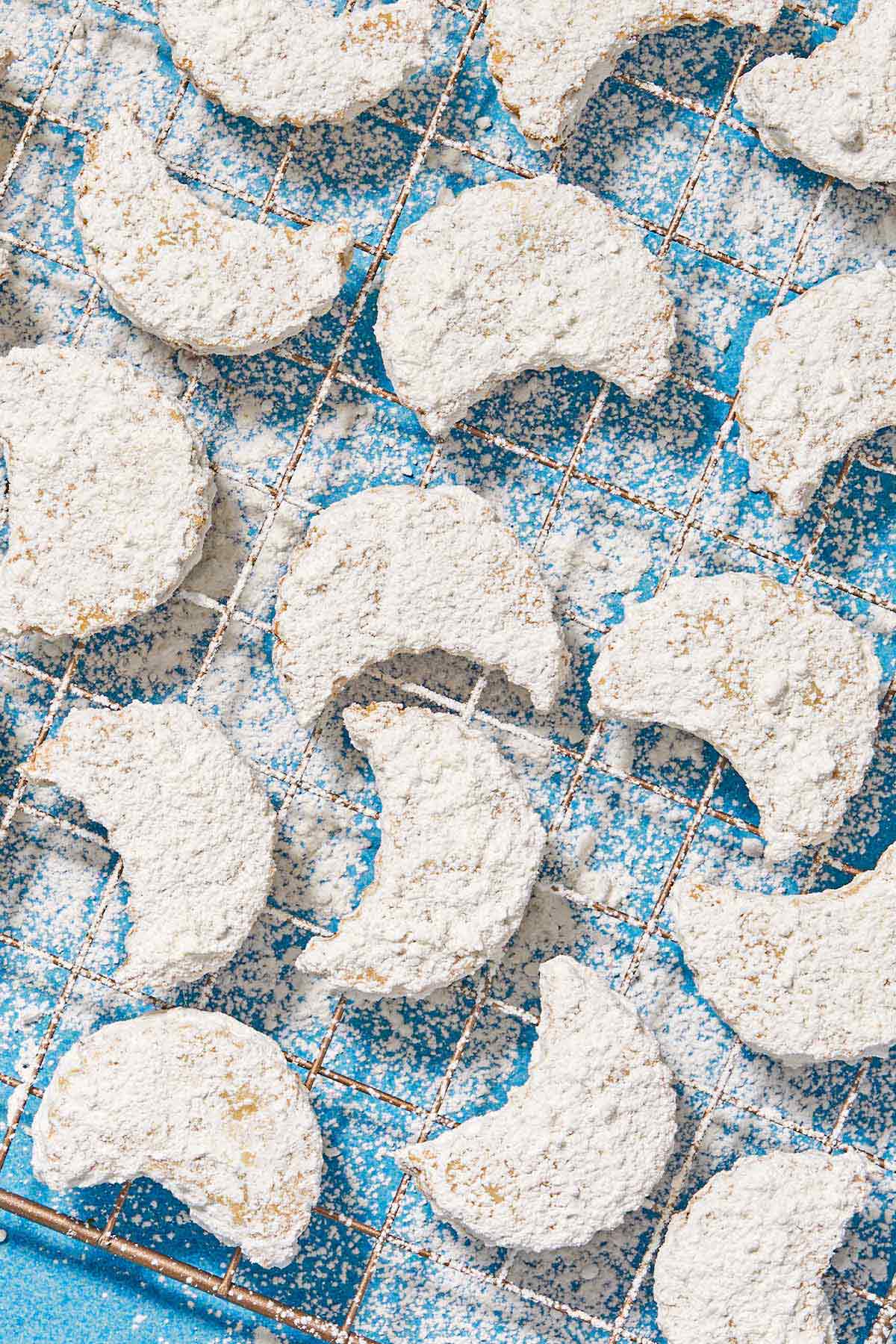
How to Make Greek Almond Cookies
When making these cookies, note a few things: Have your butter at room temperature, the nuts roasted and cooled, and the dry ingredients measured before you begin. This will help ensure that the butter mixture does not melt or change texture before it is cooked and that it all comes together nicely and efficiently. Here’s how to make them:
- Get ready. Preheat the oven to 350°F. Line 2 rimmed baking sheets with parchment paper. Place 1/3 cup whole (raw or blanched) almonds (55g) on a third, unlined, small baking sheet.
- Toast the almonds. Roast almonds until nutty and toasted, 8 to 10 minutes, then set them aside to cool completely. Increase the oven temperature to 375°F.
- Whip the butter and oil. Combine 1/2 cup room-temperature unsalted butter (113 g) and 1/2 cup plus 1 tablespoon extra virgin olive oil (140 ml) in the bowl of a stand mixer fitted with a whisk attachment. Whisk on medium speed until combined, then whisk on high speed until the mixture has become white and appears thick and fluffy in texture like buttercream frosting, about 10 minutes. This step is crucial to incorporate air into the dough.
- Chop the almonds. Meanwhile, once cooled, pulse the roasted almonds in a food processor or chop by hand until crumbly. Do not blitz completely into a powder; you want some chunks for texture. Set them aside.
- Make the cookie dough. Once whipped to a buttercream texture, with the mixer running, add 1 egg to the butter-oil mixture. Then, add 1 teaspoon vanilla extract, 1/2 teaspoon baking powder, 2 teaspoons orange zest (from 1 orange), 2 tablespoons ouzo liquor (optional), 2 tablespoons orange blossom water, and 1/3 cup packed powdered sugar (45g), and mix for one minute until combined.
- Add almonds and flour. Remove the whisk and replace it with the paddle attachment. Add crushed almonds and mix to combine. On low speed, gradually add the flour until incorporated. If the dough is too sticky, add a little more flour. The dough is ready when you can roll it into a ball, and it doesn’t stick. Do not add all the flour simultaneously, as you may not need all of it.
- Shape the dough. Place the dough on a clean work surface and use your hands to form it into a cohesive ball. Place the dough between two pieces of parchment paper. With a rolling pin, flatten and roll it out to about 3/4-inch thick (about 2-centimeters).
- Cut the cookies. Remove the top piece of parchment paper and cut the dough into crescent shapes using a cookie cutter. Use an offset spatula to gently transfer each to a baking sheet, leaving an inch between each cookie. Bring together the remaining dough and repeat until all the cookies have been shaped.
- Bake the cookies. Bake for 20 to 25 minutes or until the bottom of the cookies is golden brown and the top is slightly golden. They will still look quite pale!
- Add sugar coating. Remove the cookies from the oven and immediately brush, spritz, or sprinkle them with orange blossom water. You can also put the orange blossom water in a small spray bottle and spray the cookies to help distribute it evenly.
- Cool and coat: Allow them to cool slightly (about 5 to 8 minutes), then gently roll each one in a bowl of powdered sugar, ensuring that all sides are covered. Be gentle with them, as they are crumbly. Place them on a cooling rack to cool completely. Once they’re completely cooled, dust them with additional powdered sugar. Transfer to an airtight container or jar.
Flavor Variations
These cookies are the perfect expression of Greek identity. They are prominently featured at every Christmas lunch, they’re always served at weddings and celebrations, and one can find a jar of them in most Greek households at any time of year. Every family has their own variation, so feel free to make small adjustments to the recipe to customize these crescent cookies to your taste.
- Swap the nuts: While these cookies are typically prepared with almonds, you can replace them or include other nuts as desired. Some suggestions are roasted pecans, walnuts, or pistachios.
- Change the liquor: Ouzo liquor can also be substituted for orange liqueur or brandy.
- Swap the citrus: Lemon zest can be substituted for the orange zest.
- Try rose water instead: If orange blossom isn’t your preferred flavor, use rose water instead. You can also skip both flavors if you’d like. In that case, try adding extra vanilla or zest to enhance the flavor. If you do this, you will need less flour.
How to Shape These Cookies
I prefer cutting out the shapes using a cookie cutter rather than individually shaping them. This helps ensure consistent cooking time, as they all have similar weight and thickness.
Crescents are the most traditional shape for Kourabiedes; however, you can cut them with any cookie-cutter shape you like. They don’t spread much, or really at all, as they bake. The critical thing to remember is that to have the right texture, these cookies should be about 2 centimeters (3/4 inch) tall. You do not want a flat, thin cookie; these should have some height.
If you do want to shape them by hand instead of using a cookie cutter, gently pinch off golf ball-sized sections of dough. Gently roll each one in your hands, without compressing them too much, into a thin cylinder. Place it on the prepared baking sheet, forming it into a crescent or “C” shape.

Tips for Cookie Perfection
Kourabiedes are a simple, homey cookie, but there are a few technical points that will help give yours the most wonderful texture.
- Whip the butter and oil thoroughly. The butter and oil must be beaten well before adding the other ingredients. This air incorporated into the dough in this step, before adding the flour, is what gives these cookies their tender, crumbly texture and allows them to melt in the mouth.
- Keep them tall. When cutting the dough, the cookie must be at least 2 centimeters, or about 3/4 inch, tall; otherwise, they will turn out flat. These are not flat pancake shortbreads. Height is necessary!
- Do not overbake. The cookies should be golden underneath and slightly colored on top, but they should not be too dark; otherwise, they will be hard when they cool.
- Add the sugar in stages. It is essential to allow the cookies to cool slightly before dusting them with the final icing sugar. Some will absorb into the surface of the cookies. Adding the sugar in stages is what gives the cookie its snowy look. Feel free to add more powdered sugar again when you serve them—you cannot add too much for these cookies.
More Mediterranean Cookie Recipes
Browse all Mediterranean recipes.
Visit Our Shop.
Greek Almond Crescent Cookies (Kourabiedes)
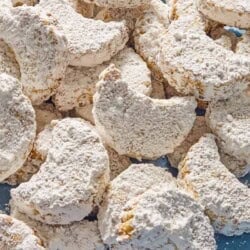
Ingredients
- 1/3 cup whole almonds (raw or blanched) (55g)
- 1/2 cup unsalted butter, at room temperature (113g)
- 1/2 cup plus 1 tablespoon extra virgin olive oil (140 ml)
- 1 egg
- 1 teaspoon vanilla extract
- 1/2 teaspoon baking powder
- 2 teaspoons orange zest (from 1 orange)
- 2 tablespoons ouzo liquor or water
- 2 tablespoons orange blossom water
- 1/3 cup packed powdered sugar (45g)
- 4 cups all-purpose flour (500g)
For the topping
- Orange blossom water
- Confectioner’s sugar
Instructions
- Get ready. Preheat the oven to 350°F. Line 2 rimmed baking sheets with parchment paper. Place almonds on a third, unlined, small baking sheet.
- Toast the almonds. Roast almonds until nutty and toasted, 8 to 10 minutes, then set them aside to cool completely. Increase the oven temperature to 375°F.
- Whip the butter and oil. Combine the butter and extra virgin olive oil in the bowl of a stand mixer fitted with a whisk attachment. Whisk on medium speed until combined, then whisk on high speed until the mixture has become white, and appears thick and fluffy in texture like buttercream frosting, about 10 minutes. This step is crucial to incorporate air into the dough.
- Chop the almonds. Meanwhile, once cooled, pulse the roasted almonds in a food processor or chop by hand until crumbly. Do not blitz completely into a powder; you want some chunks for texture. Set them aside.
- Make the cookie dough. Once whipped to a buttercream texture, with the mixer running,add the egg to the butter-oil mixture. Then, add the vanilla, baking powder, orange zest, ouzo, orange blossom water, and powdered sugar, and mix for one minute until combined.
- Add almonds and flour. Remove the whisk and replace it with the paddle attachment. Add crushed almonds and mix to combine. On low speed, gradually add the flour until incorporated. If the dough is too sticky, add a little more flour. The dough is ready when you can roll it into a ball, and it doesn’t stick. Do not add all the flour simultaneously, as you may not require it all.
- Shape the dough. Place the dough on a clean work surface and use your hands to form it into a cohesive ball. Place the dough between two pieces of parchment paper. With a rolling pin, flatten and roll it out to about 3/4-inch thick (about 2-centimeters).
- Cut the cookies. Remove the top piece of parchment paper and cut the dough into crescent shapes using a cookie cutter. Use an offset spatula to gently transfer each to a baking sheet, leaving an inch between each cookie. Bring together the remaining dough and repeat until all the cookies have been shaped.
- Bake the cookies. Bake for 20 to 25 minutes or until the bottom of the cookies is golden brown and the top is slightly golden. They will still look quite pale!
- Add sugar coating. Remove the cookies from the oven and immediately brush or sprinkle all the cookies with orange blossom water. You can also put the orange blossom water in a small spray bottle and spray the cookies to help distribute it evenly. Allow them to cool slightly (about 5 to 8 minutes), then gently roll each one in a bowl of powdered sugar, ensuring that all sides are covered. Be gentle with them, as they are crumbly. Place them on a cooling rack to cool completely. Once they’re completely cooled, dust them with the remaining powdered sugar. Transfer to an airtight container or jar.
Notes
- Shop this recipe: Visit our shop to browse quality Mediterranean ingredients, including the olive oil and orange blossom water used in this recipe.
- Storage: Kourabiedes can be stored for up to two months in an airtight container at room temperature. When serving, dust them with additional powdered sugar.
Nutrition
Ó•Florale 100% Natural Orange Blossom Water
Made using a time-honored distillation process, a splash adds a delicate and aromatic quality to sweet and savory dishes, from marinades and salad dressings to cocktails and rice pudding.
